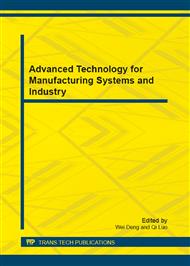[1]
Forsythe W K, Bliss D W. MIMO Radar Waveform Constraints for GMTI[J]. IEEE Journal of Selected Topics in Signal Processing., 2010, 4(1): 21~32.
DOI: 10.1109/jstsp.2009.2038969
Google Scholar
[2]
Wang G, Lu Y, Sun J. STAP performance analysis for MIMO radar with waveform diversity[C].2009 IEEE Radar Conference, RADAR 2009, May 4, 2009 - May 8, 2009, Pasadena, CA, United states: Institute of Electrical and Electronics Engineers Inc., 2009.
DOI: 10.1109/radar.2009.4976936
Google Scholar
[3]
Hassanien A, Vorobyov S A. Phased-MIMO Radar: A Tradeoff between Phased-Array and MIMO Radars[J]. IEEE Transaction Signal Processing, 2010, 55(1): 26~32.
DOI: 10.1109/tsp.2010.2043976
Google Scholar
[4]
Friedlander B. Waveform design for MIMO radar with space-time constraints[C].41st Asilomar Conference on Signals, Systems and Computers, ACSSC, November 4, 2007 - November 7, 2007, Pacific Grove, CA, United states: Inst. of Elec. and Elec. Eng. Computer Society, 2007.
DOI: 10.1109/acssc.2007.4487624
Google Scholar
[5]
Guerci J R. Cognitive Radar-The Knowledge-Aidded Fully Adaptive Approach[M] . Boston,London: Artech House, 2010. 91~109.
Google Scholar
[6]
Mecca V F, Ramakrishnan D, Krolik J L. MIMO radar space-time adaptive processing for multipath clutter mitigation[J]. IEEE Workshop on Sens. Array and Multichannel Signal Process, 2006: 249~253.
Google Scholar
[7]
Abramovich Y I, Frazer G J, Johnson B A. Noncausal adaptive spatial clutter mitigation in monostatic mimo radar: Fundamental limitations[J]. IEEE Journal on Selected Topics in Signal Processing, 2010, 4(1): 40~54.
DOI: 10.1109/jstsp.2009.2038966
Google Scholar
[8]
Wang Y, Wu Z, Peng Y. STAP approach for the non-homogeneous radar clutter environment[J]. Tien Tzu Hsueh Pao/Acta Electronica Sinica, 1999, 27(9): 56~62.
Google Scholar
[9]
Chen C Y, Vaidyanathan P P. MIMO radar space-time adaptive processing using prolate spheroidal wave functions. [J]. IEEE Trans. on Signal Processing, 2008, 56(2): 623~635.
DOI: 10.1109/tsp.2007.907917
Google Scholar
[10]
Harry L. Detection,Estimation,and Modulation Theory,Part I[M] . John Wiley &Sons: 2001. 231~234.
Google Scholar


